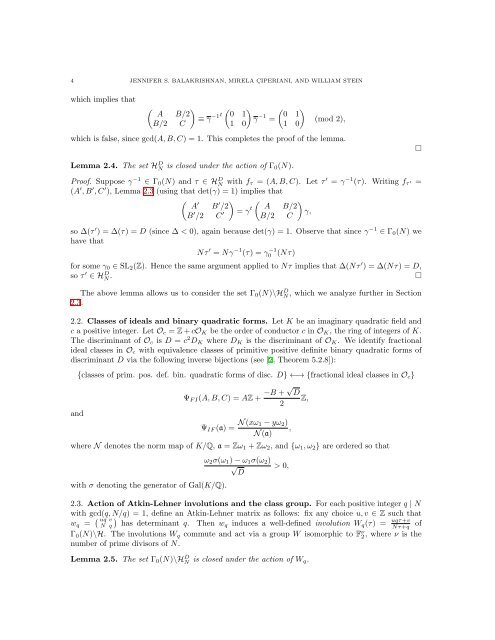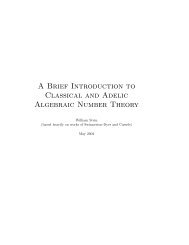p-ADIC HEIGHTS OF HEEGNER POINTS AND ANTICYCLOTOMIC ...
p-ADIC HEIGHTS OF HEEGNER POINTS AND ANTICYCLOTOMIC ...
p-ADIC HEIGHTS OF HEEGNER POINTS AND ANTICYCLOTOMIC ...
Create successful ePaper yourself
Turn your PDF publications into a flip-book with our unique Google optimized e-Paper software.
4 JENNIFER S. BALAKRISHNAN, MIRELA ÇIPERIANI, <strong>AND</strong> WILLIAM STEIN<br />
which implies that<br />
<br />
A B/2<br />
≡ γ<br />
B/2 C<br />
−1t<br />
<br />
0 1<br />
γ<br />
1 0<br />
−1 =<br />
<br />
0 1<br />
1 0<br />
(mod 2),<br />
which is false, since gcd(A, B, C) = 1. This completes the proof of the lemma.<br />
Lemma 2.4. The set H D N<br />
is closed under the action of Γ0(N).<br />
Proof. Suppose γ−1 ∈ Γ0(N) and τ ∈ HD N with fτ = (A, B, C). Let τ ′ = γ−1 (τ). Writing fτ ′ =<br />
(A ′ , B ′ , C ′ ), Lemma 2.3 (using that det(γ) = 1) implies that<br />
<br />
′ A B ′ /2<br />
B ′ /2 C ′<br />
<br />
= γ t<br />
<br />
A B/2<br />
γ,<br />
B/2 C<br />
so ∆(τ ′ ) = ∆(τ) = D (since ∆ < 0), again because det(γ) = 1. Observe that since γ−1 ∈ Γ0(N) we<br />
have that<br />
Nτ ′ = Nγ −1 (τ) = γ −1<br />
0 (Nτ)<br />
for some γ0 ∈ SL2(Z). Hence the same argument applied to Nτ implies that ∆(Nτ ′ ) = ∆(Nτ) = D,<br />
so τ ′ ∈ HD N . <br />
The above lemma allows us to consider the set Γ0(N)\HD N , which we analyze further in Section<br />
2.3.<br />
2.2. Classes of ideals and binary quadratic forms. Let K be an imaginary quadratic field and<br />
c a positive integer. Let Oc = Z + cOK be the order of conductor c in OK, the ring of integers of K.<br />
The discriminant of Oc is D = c 2 DK where DK is the discriminant of OK. We identify fractional<br />
ideal classes in Oc with equivalence classes of primitive positive definite binary quadratic forms of<br />
discriminant D via the following inverse bijections (see [2, Theorem 5.2.8]):<br />
and<br />
{classes of prim. pos. def. bin. quadratic forms of disc. D} ←→ {fractional ideal classes in Oc}<br />
ΨF I(A, B, C) = AZ + −B + √ D<br />
Z,<br />
2<br />
ΨIF (a) = N (xω1 − yω2)<br />
,<br />
N (a)<br />
where N denotes the norm map of K/Q, a = Zω1 + Zω2, and {ω1, ω2} are ordered so that<br />
with σ denoting the generator of Gal(K/Q).<br />
ω2σ(ω1) − ω1σ(ω2)<br />
√ D<br />
2.3. Action of Atkin-Lehner involutions and the class group. For each positive integer q | N<br />
with gcd(q, N/q) = 1, define an Atkin-Lehner matrix as follows: fix any choice u, v ∈ Z such that<br />
wq = uq v <br />
N q has determinant q. Then wq induces a well-defined involution Wq(τ) = uqτ+v<br />
Nτ+q of<br />
Γ0(N)\H. The involutions Wq commute and act via a group W isomorphic to F ν 2, where ν is the<br />
number of prime divisors of N.<br />
> 0,<br />
Lemma 2.5. The set Γ0(N)\HD N is closed under the action of Wq.
















